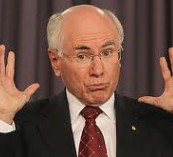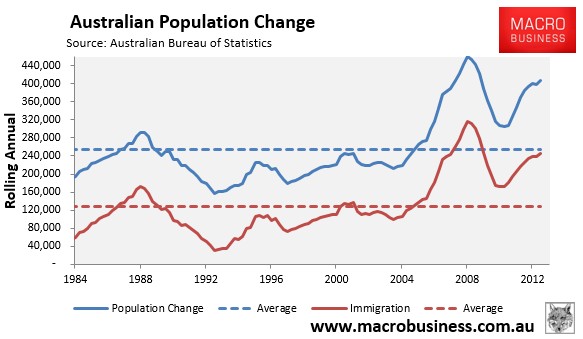
One of the most profound changes affecting the Australian economy and society over the past decade has been the massive lift in Australia’s net immigration, which surged from the mid-2000s and is running at roughly twice the pace of long-run norms (see next chart).

Concerns over a “Big Australia” have been rising in the electorate, with many worried about the growing infrastructure deficit, declining housing affordability, and environmental degradation. Even Alan Kohler – whose publication Business Spectator (owned by Rupert Murdoch) has enthusiastically endorsed high immigration and population growth – seemingly broke rank this week, declaring an “infrastructure emergency” on the back of rapid population growth:
One of Australia’s many political ironies is that the national effort to Stop The Boats has disguised an immigration boom.
Immigration has increased five-fold since the Howard government came to office and with a big increase in births over the past ten years, in part also due to Howard government policies, Australia’s total population growth has doubled and is now about three times that of most other developed countries…
Last year Australia’s population grew 1.8 per cent, or 407,000, compared with 0.7 per cent for the United States, 0.5 per cent for Europe and China, and minus 0.1 per cent for Japan.
The extra 400,000 or so people a year is the reason Australia has not had a recession for 23 years and it’s why GDP growth is now around 2.5 per cent. On a per capita basis, Australia’s economic growth is among the weakest in the world, and per capita consumption growth is zero.
In other words, population growth is the only reason it looks like the economy is growing.
One obvious consequence of Australia’s population boom, apart from disguising a fundamentally weak economy, is rising house prices because not enough houses are being built as a result of restrictive planning laws and high construction costs.
Not enough infrastructure is being built either, to the point where a national emergency is approaching.
Yesterday, former Prime Minister, John Howard, gave an interview on Radio National where, at the nine minute mark, he said the following about Australian immigration policy under his watch:
“Every country does have the right to decide the composition, the manner, and the timing of the flow of people. And that’s something the Australian people support…
One of the reasons why it is so important to maintain that policy is that the more people think our borders are being controlled, the more supportive they are in the long-term of higher levels of immigration.
Australia needs a high level of immigration. I’m a high immigration man. I practiced that in Government. And one of the ways that you maintain public support for that is to communicate to the Australian people a capacity to control our borders and decide who and what people and when they come to this country”
Correct me if I am wrong, but when did John Howard ever articulate to the Australian people that the Government was going to dramatically expand the nation’s immigration intake?
From my recollection of events, Australia’s immigration intake was increased by stealth first under the Howard Government, then continued by the Rudd/Gillard Governments, and now under the Abbott Government. There was never any community consultation on the issue or any national discussion.
John Howard’s claim that Australia needs a high level of immigration is also spurious and has been debunked numerous times on this blog (for example, see here). Nor does it align with the Productivity Commission’s findings that immigration is neither beneficial for the economy or living standards, or that immigration can alleviate the impacts of an ageing population.
It would be nice if politicians examined the facts, and gauged the community’s views, before pursuing the current high population (immigration) growth strategy. This way, Australia might not have been left with an “infrastructure emergency” and housing problems on a grand scale.

